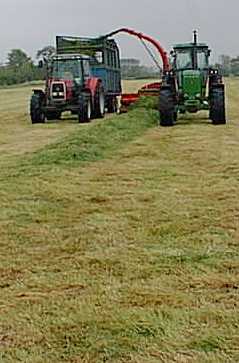| Farm-Direct |
| Quick Index |
Grass |  |
|
 Grass is the invisible crop.
When you survey a green field don't be tempted to dismiss it as
just grass, it is one of the most important crops on the farm. You
are looking at the milk, beef or lamb that you will consume in the coming
months. In summer the animals graze the grass directly but a good farmer
grows far more grass than his stock can eat in one go. Grass has to be
grown and harvested in the summer for it is not always available.
Grass is the invisible crop.
When you survey a green field don't be tempted to dismiss it as
just grass, it is one of the most important crops on the farm. You
are looking at the milk, beef or lamb that you will consume in the coming
months. In summer the animals graze the grass directly but a good farmer
grows far more grass than his stock can eat in one go. Grass has to be
grown and harvested in the summer for it is not always available.
When the grass stops growing in winter cattle are fed hay or silage as their main feed.
Hay is cut and allowed to dry in the field. It has to be turned over after a while or some may remain damp and go mouldy. Once dry it is baled and stored under cover. Hay must not turned too often or handled unduly as it loses most of its scent and flavour and stock will be reluctant to eat it. If it has lost flavour - perhaps it was wetted by rain and had to be turned several times - then it might still be usable if some flavour is added. Molasses is sometimes sprinkled into second rate hay to encourage cattle to eat.
Grass is cut and then wilted - allowed to dry slightly and go limp. It is then kept from the air - sometimes in a bulk silage clamp, sometimes baled in a plastic wrapper. The grass starts to ferment and produces acids that pickle and preserve it in an edible condition. This pickling fermentation is very similar to the process that makes yoghurt. Silage is really yoghurtificated grass. Air must be kept away from silage or it will spoil and rot.
A more detailed technical discussion of grass and deeper explanation of hay and silage may be of interest.
| Farm-Direct |
| Quick Index |